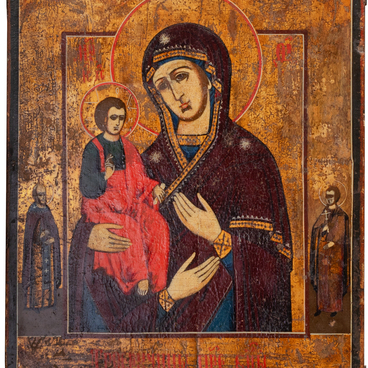The icon depicts a bust-length image of Seraphim of Sarov dressed in a black robe with folds repainted in gold and a white epitrachelion with brown four-pointed crosses. In his left hand, there is a rosary as a symbol of unceasing prayer. The background of the centerpiece is decorated with an embossed pattern. The décor (a strip of bright paint framing the icon along its outer edge) is made with a floral pattern in polychrome enamels. Around the head of St. Seraphim is a halo in the form of shining rays framed by blue dot ornamentation. In some icons painted before Seraphim’s canonization, the Monk is depicted without a halo.
Seraphim was a hieromonk of the Sarov Monastery, the founder and patron saint of the Diveyevo Convent. St. Seraphim of Sarov is one of the most revered Orthodox saints. According to his hagiography, the hieromonk led a secluded life of asceticism in the forest, far from the monastery. Seraphim wore the same clothes in winter and summer, obtained his own food, and fasted strictly. According to some testimonies, he spent a long time eating only the grass of goutweed, and spent a thousand days and nights in the endeavor of stylitism, standing on a stone boulder. In the last decades of his life, Seraphim assumed the monastic endeavor of silence.
The icons depicting the Monk feature an obligatory attribute — a prayer rosary (“lestovki”) in his left hand. The image of Seraphim of Sarov was created in a tradition based on the repetition of his lifetime portraits by the monk Joseph (Serebryakov) and the painter of the Imperial Academy of Arts Dmitry Evstafiev. This repetition was important, among other things, because the elder personally gave his images to his spiritual children as a consolation and prayerful remembrance. Pilgrims recalled their awe at the sensation of the presence of the elder before his portraits: the countenance “came to life” and they saw St. Seraphim “as if alive”.
In this icon, the painter emphasized the elder’s
advanced years and deep wrinkles, recalling his ascetic labors, the
mortification of the flesh, and the thousand-day prayer of the stylite. Some
icons of the saint depict rays in the upper left corner — the “iconic” light
that dawns upon the Monk. This element is found in depictions of his righteous
demise, prayerful standing on a stone before an icon of the Virgin Mary, and in
full-height depictions of the saint against the background of the monastery
with the Lord Almighty or the Mother of God in heaven.

